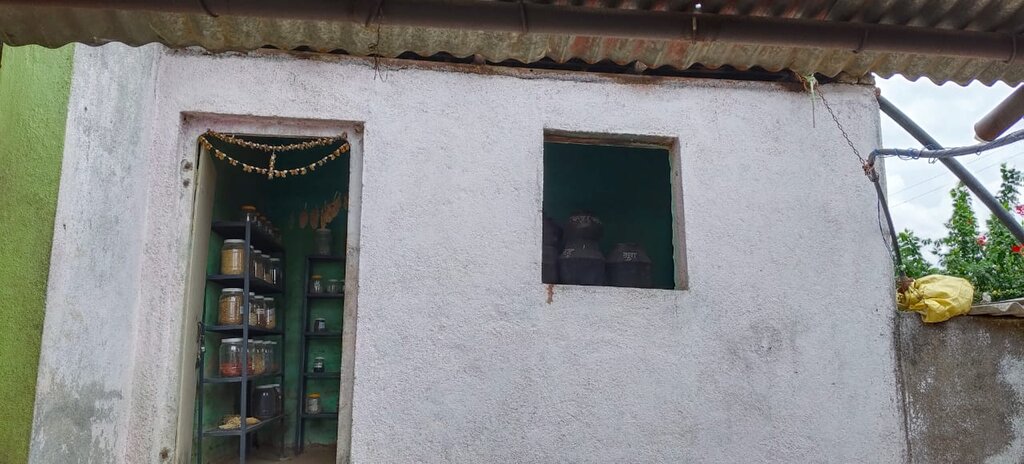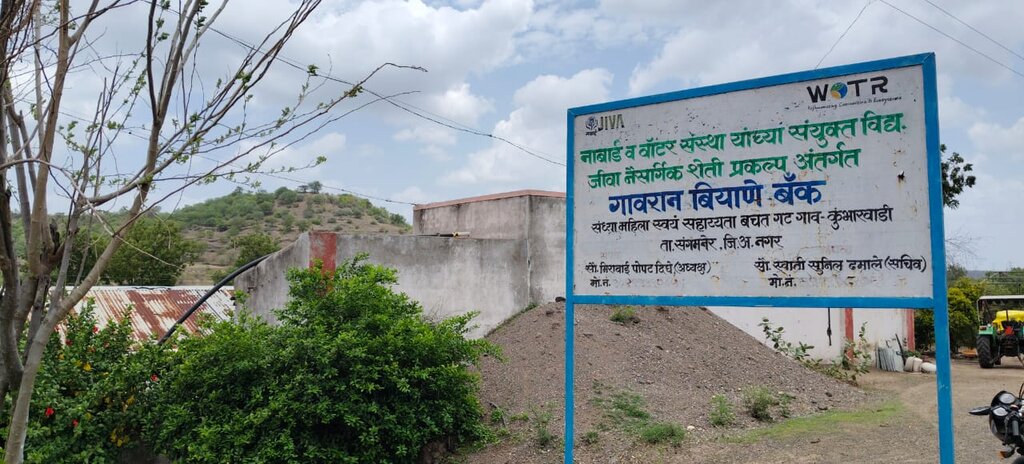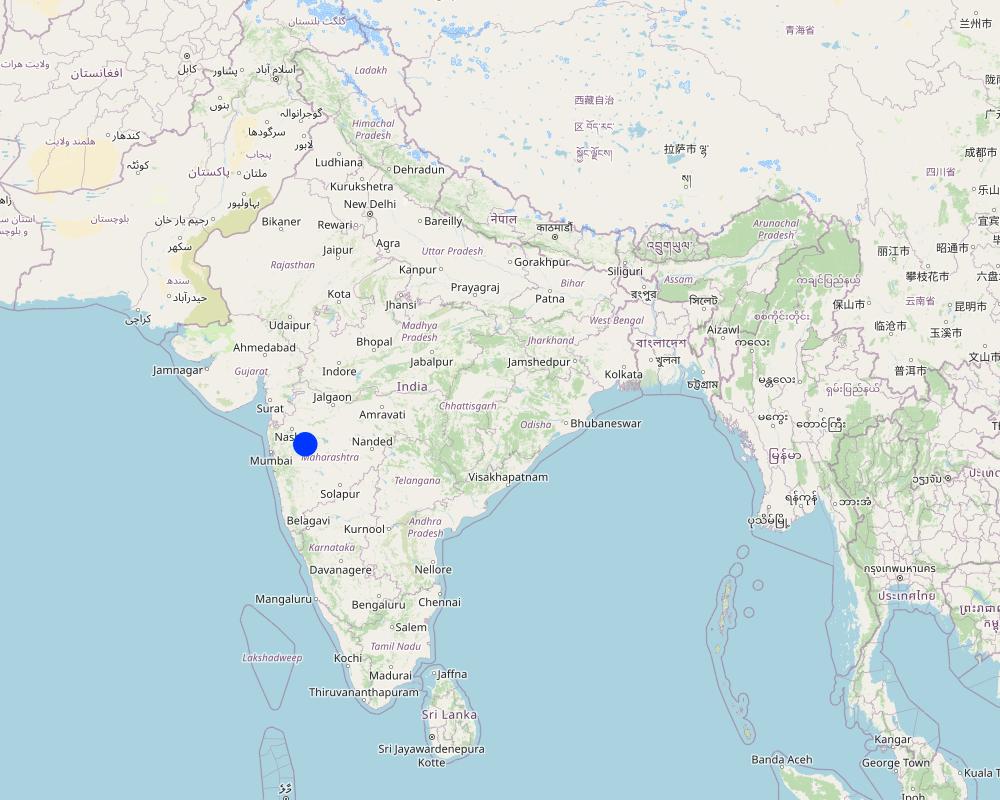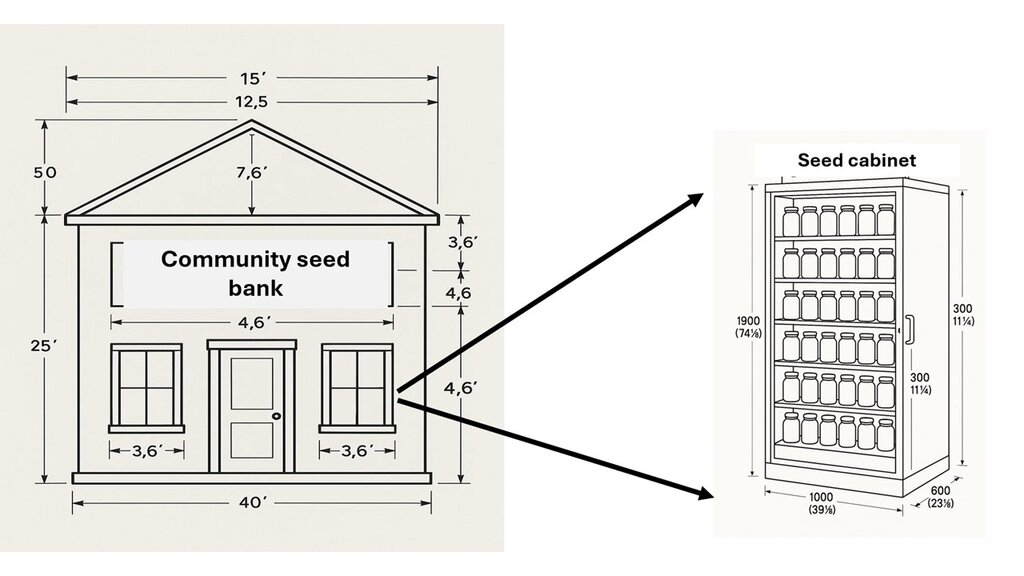Community seed banks [印度]
- 创建:
- 更新:
- 编制者: Pratik Ramteke
- 编辑者: –
- 审查者: Rima Mekdaschi Studer, William Critchley
Seed banks
technologies_7552 - 印度
查看章节
全部展开 全部收起1. 一般信息
1.2 参与该技术评估和文件编制的资源人员和机构的联系方式
有助于对技术进行记录/评估的项目名称(如相关)
Enabling Agro-ecological Transitions in Rainfed Landscapes (JIVA)有助于对技术进行记录/评估的机构名称(如相关)
Watershed Organisation Trust (WOTR) - 印度1.3 关于使用通过WOCAT记录的数据的条件
编制者和关键资源人员接受有关使用通过WOCAT记录数据的条件。:
是
1.4 所述技术的可持续性声明
这里所描述的技术在土地退化方面是否存在问题,导致无法被认为是一种可持续的土地管理技术?:
否
2. SLM技术的说明
2.1 技术简介
技术定义:
A community-based seed bank system is a locally managed initiative where farmers and community members collect, store, and share seeds to ensure germplasm and food security, preserve crop diversity, and support sustainable agriculture. These banks are governed by community rules.
2.2 技术的详细说明
说明:
Community Seed Banks (CSBs) are locally governed systems designed to enhance food and seed security, promote sustainable, climate-resilient farming as well as conserving agrobiodiversity. CSBs bridge traditional agricultural knowledge with evolving best practices, ensuring the continuity of seed diversity adapted to local conditions.
A key function of CSBs is seed preservation and exchange. They provide for the collection of seeds from farmers, prioritizing varieties that have demonstrated superior local adaptation. Seeds are carefully cleaned, dried, and tested for viability before being stored—typically in clay pots in a simple building. The preserved seeds can be used in future planting seasons or distributed during droughts, floods, or pest outbreaks, thereby ensuring timely access to reliable seed material.
A CBS conserves and manages a diverse range of locally important crops including both cereals (sorghum and maize) and legumes (black grams, chickpeas, cowpeas, green grams, green peas, groundnuts, horse grams, red grams, and soybeans). Several traditional and improved cultivars of each crop are stored, selected on their performance under local conditions, including drought tolerance, pest and disease resistance, yield stability, and cultural preference. The quantity of seeds stored per cultivar ranges from 500 grams to 100 kilograms, depending on availability and community demand. For seed protection, both indigenous practices and materials such as wood ash, neem leaves (Azadirachta indica), and chili extract (Capsicum frutescens) are used to prevent pest infestation during storage, minimizing reliance on commercial pesticides.
Management of CSBs is local and participatory. They are generally governed by elected community committees that set the rules for deposit, withdrawal and replenishment. This governance structure ensures that the seed bank reflects the specific needs and knowledge systems of the community. Community engagement is not only vital for operational success but also fosters a sense of ownership and collective responsibility.
CSBs play a multifaceted role. They contribute to agrobiodiversity conservation by safeguarding traditional and wild crop varieties, which are invaluable for future breeding programs. Furthermore, they ensure that farmers can access seeds during critical periods. Additionally, CSBs promote sustainable agricultural practices by reducing reliance on commercial seed systems. They also help to document and share traditional farming knowledge.
The operational structure of a CSB begins with community mobilization and capacity-building focused on seed selection, handling, and storage. Infrastructure requirements are modest. Maintenance involves tasks such as viability testing to ensure the germination potential of stored seeds.
CSBs enhance the resilience of agricultural systems by enabling communities to recover swiftly from crop failures: they also reduce input costs. Furthermore, CSBs empower communities—particularly smallholder farmers and women. Moreover, these banks store vital genetic material for future research.
From a community perspective, the benefits are substantial. However, challenges remain. High initial investments in infrastructure and training are required, and ongoing success depends on strong community engagement and diligent record-keeping. Nevertheless, by preserving the genetic heritage of crops and empowering local communities, CSBs reduce contribute to food sovereignty
2.3 技术照片
2.5 已应用该技术的、本评估所涵盖的国家/地区/地点
国家:
印度
区域/州/省:
Maharashtra
有关地点的进一步说明:
Kumbharwadi village, Tal. Sangamner, Dist: Ahilyanagar
具体说明该技术的分布:
- 适用于特定场所/集中在较小区域
技术现场是否位于永久保护区?:
否
注释:
This documentation covers a single CSB located at Kumbharwadi village.
Map
×2.6 实施日期
注明实施年份:
2024
2.7 技术介绍
详细说明该技术是如何引入的:
- 通过项目/外部干预
注释(项目类型等):
JIVA – An Agroecology-Based Programme, Implementing Agency: National Bank for Agriculture and Rural Development (NABARD)
3. SLM技术的分类
3.1 该技术的主要目的
- 改良生产
- 保持/提高生物多样性
- 适应气候变化/极端天气及其影响
- 创造有益的经济影响
- 创造有益的社会影响
3.2 应用该技术的当前土地利用类型
同一土地单元内混合使用的土地::
是
具体说明混合土地使用(作物/放牧/树木):
- 农林业

农田
- 一年一作
- 乔木与灌木的种植
年作 - 具体指明作物:
- 谷物类 - 玉米
- 谷类 - 小米
- 饲料作物 - 苜蓿
- 豆科牧草和豆类 - 大豆
- 蔬菜 - 根茎类蔬菜(胡萝卜、洋葱、甜菜等)
乔木和灌木种植 - 指定作物:
- 芒果、山竹果、番石榴
- Custard Apple
每年的生长季节数:
- 2
采用间作制度了吗?:
是
如果是,说明哪些作物是间作的:
Red gram, black gram and green gram intercropped with pearl millet or soybean;
cowpea, horse gram intercropped with groundnuts
采用轮作制度了吗?:
是
如果是,请具体说明:
Cereals-pulses

森林/林地
- 植树造林

水道、水体、湿地
- 池塘、大坝
主要产品/服务:
Irrigation and domestic use
3.3 由于技术的实施,土地使用是否发生了变化?
由于技术的实施,土地使用是否发生了变化?:
- 否(继续问题3.4)
3.4 供水
该技术所应用土地的供水:
- 混合雨水灌溉
注释:
Irrigation source: well, farm pond
3.5 该技术所属的SLM组
- 病虫害综合管理(包括有机农业)
- 改良植物品种/动物品种
- 减少基于生态系统的灾害风险
3.6 包含该技术的可持续土地管理措施

结构措施
- S9:动植物庇护所
- S11:其它
注释:
The CSB includes permanent infrastructure (e.g., a small house or storage facility built with community effort) for the secure preservation and storage of seeds.
3.7 该技术强调的主要土地退化类型

化学性土壤退化
- Cn:肥力下降和有机质含量下降(非侵蚀所致)

生物性退化
- Bh:栖息地丧失
- Bs:质量和物种组成/多样性的下降
- Bp:害虫/疾病增加,捕食者减少

水质恶化
- Hg:地下水/含水层水位的变化

其它
具体说明:
Agrobiodiversity loss and climate-related seed insecurity
→ The CSB addresses the degradation of crop genetic resources, which is a foundational pillar of sustainable land management.
3.8 防止、减少或恢复土地退化
具体数量名该技术与土地退化有关的目标:
- 防止土地退化
- 减少土地退化
注释:
→ By conserving traditional seed varieties that require fewer external inputs, the CSB helps prevent soil and biodiversity degradation.
→ Promoting resilient, diverse, and low-input seed systems contributes to reducing ongoing degradation (e.g., fertility decline, loss of biodiversity).
4. 技术规范、实施活动、投入和成本
4.1 该技术的技术图纸
技术规范(与技术图纸相关):
The structure shown is for reference. Any enclosed room with suitable ventilation and storage conditions can serve as a seed bank.
More detail of storage pots and a brief description:
The seed bank utilizes traditional earthen pots (locally known as matka or bharani) and airtight glass/plastic jars as primary storage containers. The large clay pots are arranged on raised platforms and shelves to avoid moisture contact from the floor. These pots are labelled in local script (Marathi), clearly indicating the crop name (e.g., sorghum, cowpea, maize, etc.) and variety stored. Each pot is covered with cloth and tied securely, ensuring ventilation while preventing pest entry.
These earthen pots are ideal for seed storage in rural, low-cost setups as they:
•Maintain cool internal temperatures, reducing seed deterioration.
•Are naturally aerated, preventing moisture buildup.
•Can be easily sealed using cloth or organic sealants like cow dung or ash to control pests.
The glass and plastic jars used on metal racks are suited for small seed quantities, mainly for short-term storage or display during training sessions and exchanges. Each jar is labelled with variety and harvest details, supporting proper documentation and traceability.
作者:
Pratik Ramteke
日期:
12/05/2025
4.2 有关投入和成本计算的一般信息
具体说明成本和投入是如何计算的:
- 每个技术单元
指定单位:
1
指定单位面积(如相关):
A typical unit consists of a single room structure (approx. 10 x 10 feet) equipped with traditional clay pots (15–25 units) and glass or plastic jars (20–50 units) used for storing seeds. The average storage capacity of one unit is approximately 200–500 kg, depending on the number of crop varieties and seasonal seed availability.
其它/国家货币(具体说明):
Indian Rupees
如相关,注明美元与当地货币的汇率(例如1美元=79.9巴西雷亚尔):1美元=:
84.0
注明雇用劳工的每日平均工资成本:
500
4.3 技术建立活动
| 活动 | 时间(季度) | |
|---|---|---|
| 1. | Site selection for seed bank structure (within SHG household/community building) | February–March (before Rabi harvest) |
| 2. | Construction/preparation of storage structure (room cleaning, plastering, shelf fixing) | March–April |
| 3. | Procurement of local seed varieties | April–May (before monsoon/ Kharif sowing) |
| 4. | Procurement and setup of seed storage containers (clay pots, glass jars, bags) | April–May (before onset of rain) |
| 5. | Installation of racks, shelves, moisture absorbers | May |
| 6. | Labelling of containers and organization of storage system | May–June |
| 7. | Setup of documentation tools (register books, seed stock cards) | June (onset of monsoon) |
4.4 技术建立所需要的费用和投入
| 对投入进行具体说明 | 单位 | 数量 | 单位成本 | 每项投入的总成本 | 土地使用者承担的成本% | |
|---|---|---|---|---|---|---|
| 劳动力 | Trainer Fees | person days | 1.0 | 2500.0 | 2500.0 | |
| 设备 | Furniture / Rack | pieces | 10.0 | 800.0 | 8000.0 | |
| 设备 | Seed Store Jar and Bag | pieces | 200.0 | 20.0 | 4000.0 | |
| 植物材料 | Purchase of seed | kg | 50.0 | 450.0 | 22500.0 | |
| 其它 | Training food charges, materials, boards, exposure visit charges, register book, charts, etc. | 1.0 | 8100.0 | 8100.0 | ||
| 技术建立所需总成本 | 45100.0 | |||||
| 技术建立总成本,美元 | 536.9 | |||||
如果土地使用者负担的费用少于100%,请注明由谁负担其余费用:
Project
注释:
Around 90-95% of costs were supported by the implementing project JIVA (NABARD), while the remaining was contributed by the community through local materials and voluntary labour
4.5 维护/经常性活动
| 活动 | 时间/频率 | |
|---|---|---|
| 1. | Labour (e.g., supervision, helpers) | each cropping season |
| 2. | Replacement of broken jars | as per need |
| 3. | Labelling changes (charts, tags) | annually |
| 4. | Equipment maintenance and repair | as per need |
4.6 维护/经常性活动所需要的费用和投入(每年)
| 对投入进行具体说明 | 单位 | 数量 | 单位成本 | 每项投入的总成本 | 土地使用者承担的成本% | |
|---|---|---|---|---|---|---|
| 劳动力 | Labour (e.g., supervision, helpers) | man-days | 10.0 | 300.0 | 3000.0 | |
| 设备 | Replacement of broken jars | pieces | 10.0 | 20.0 | 200.0 | |
| 设备 | Labelling changes (charts, tags) | 5.0 | 300.0 | 1500.0 | ||
| 设备 | Equipment maintenance and repair | 1.0 | 2000.0 | 2000.0 | ||
| 植物材料 | 1.0 | |||||
| 技术维护所需总成本 | 6700.0 | |||||
| 技术维护总成本,美元 | 79.76 | |||||
如果土地使用者负担的费用少于100%,请注明由谁负担其余费用:
Project (see above under Establishment)
4.7 影响成本的最重要因素
描述影响成本的最决定性因素:
1. Seed procurement and quality maintenance
2. Storage infrastructure (jars, bags, racks)
3. Training and capacity building for SHGs
4. Labelling and documentation materials
5. Community engagement and operational labour
6. Monitoring and evaluation activities
7. Exposure visits and knowledge sharing
8. Replacement and maintenance of storage materials
5. 自然和人文环境
5.1 气候
年降雨量
- < 250毫米
- 251-500毫米
- 501-750毫米
- 751-1,000毫米
- 1,001-1,500毫米
- 1,501-2,000毫米
- 2,001-3,000毫米
- 3,001-4,000毫米
- > 4,000毫米
指定年平均降雨量(若已知),单位为mm:
450.00
农业气候带
- 半干旱
5.2 地形
平均坡度:
- 水平(0-2%)
- 缓降(3-5%)
- 平缓(6-10%)
- 滚坡(11-15%)
- 崎岖(16-30%)
- 陡峭(31-60%)
- 非常陡峭(>60%)
地形:
- 高原/平原
- 山脊
- 山坡
- 山地斜坡
- 麓坡
- 谷底
垂直分布带:
- 0-100 m a.s.l.
- 101-500 m a.s.l.
- 501-1,000 m a.s.l.
- 1,001-1,500 m a.s.l.
- 1,501-2,000 m a.s.l.
- 2,001-2,500 m a.s.l.
- 2,501-3,000 m a.s.l.
- 3,001-4,000 m a.s.l.
- > 4,000 m a.s.l.
说明该技术是否专门应用于:
- 不相关
5.3 土壤
平均土层深度:
- 非常浅(0-20厘米)
- 浅(21-50厘米)
- 中等深度(51-80厘米)
- 深(81-120厘米)
- 非常深(> 120厘米)
土壤质地(表土):
- 粗粒/轻(砂质)
土壤质地(地表以下> 20厘米):
- 粗粒/轻(砂质)
表土有机质:
- 低(<1%)
如有可能,附上完整的土壤描述或具体说明可用的信息,例如土壤类型、土壤酸碱度、阳离子交换能力、氮、盐度等。:
calcareous
5.4 水资源可用性和质量
地下水位表:
5-50米
地表水的可用性:
匮乏/没有
水质(未处理):
不良饮用水(需要处理)
水质请参考::
地下水
水的盐度有问题吗?:
是
该区域正在发生洪水吗?:
否
5.5 生物多样性
物种多样性:
- 高
栖息地多样性:
- 中等
关于生物多样性的注释和进一步规范:
The Community Seed Bank maintains and promotes high agrobiodiversity in the surrounding farming areas by preserving a wide range of traditional and locally adapted crop varieties. In total, over 30+ landraces/varieties across 2 cereals and 9 legumes/ pulses (sorghum, maize; green grams, chick peas, horse grams, cowpeas, red grams, green peas, black grams, soybeans and groundnuts) are being actively conserved and circulated in the local community. This contributes significantly to on-farm agrobiodiversity, improves ecosystem resilience, and reduces dependence on uniform commercial seed systems. The continued use and exchange of these seeds by farmers helps sustain crop diversity in the region.
5.6 应用该技术的土地使用者的特征
定栖或游牧:
- 定栖的
生产系统的市场定位:
- 混合(生计/商业)
- 商业/市场
非农收入:
- 收入的10-50%
相对财富水平:
- 平均水平
个人或集体:
- 个人/家庭
机械化水平:
- 手工作业
- 机械化/电动
性别:
- 女人
- 男人
土地使用者的年龄:
- 青年人
- 中年人
- 老年人
5.7 应用该技术的土地使用者使用的平均土地面积
- < 0.5 公顷
- 0.5-1 公顷
- 1-2 公顷
- 2-5公顷
- 5-15公顷
- 15-50公顷
- 50-100公顷
- 100-500公顷
- 500-1,000公顷
- 1,000-10,000公顷
- > 10,000公顷
这被认为是小规模、中规模还是大规模的(参照当地实际情况)?:
- 中等规模的
5.8 土地所有权、土地使用权和水使用权
土地所有权:
- 社区/村庄
- 个人,有命名
土地使用权:
- 社区(有组织)
- 个人
用水权:
- 社区(有组织)
- 个人
土地使用权是否基于传统的法律制度?:
是
具体说明:
Land is traditionally managed by village communities or panchayats, with individual families allocated specific plots for cultivation, based on customary rights and community norms.
注释:
Both formal titles and long-standing traditional practices often govern land and water use. Community seed bank activities are usually hosted on land provided by local institutions or SHGs with shared usage rights.
5.9 进入服务和基础设施的通道
健康:
- 贫瘠
- 适度的
- 好
教育:
- 贫瘠
- 适度的
- 好
技术援助:
- 贫瘠
- 适度的
- 好
就业(例如非农):
- 贫瘠
- 适度的
- 好
市场:
- 贫瘠
- 适度的
- 好
能源:
- 贫瘠
- 适度的
- 好
道路和交通:
- 贫瘠
- 适度的
- 好
饮用水和卫生设施:
- 贫瘠
- 适度的
- 好
金融服务:
- 贫瘠
- 适度的
- 好
6. 影响和结论性说明
6.1 该技术的现场影响
社会经济效应
生产
作物生产
注释/具体说明:
The Community Seed Bank has contributed to stabilizing crop production rather than significantly increasing it. By providing access to diverse, locally adapted, and resilient seed varieties, the seed bank has helped reduce yield losses during droughts, erratic rainfall, and pest outbreaks, which are common in the region. Farmers report more consistent harvests across seasons, especially in rainfed areas where climate variability poses a major risk.
饲料生产
注释/具体说明:
Community seed banks play a crucial role in enhancing fodder production, particularly in smallholder and mixed farming systems. By conserving and providing access to diverse and locally adapted fodder crop varieties, these seed banks help improve the availability and quality of fodder throughout the year. This supports livestock health and productivity, especially during dry seasons or climate-induced fodder shortages. Moreover, farmers can select fodder species that are well-suited to local conditions, which enhances biomass yield and nutritional content. As a result, community seed banks contribute to better livestock management, reduced feed costs, and improved farm income and resilience.
A few traditional fodder crops are also conserved through the seed bank, including:
•Sorghum (dual-purpose varieties used for both grain and fodder)
•Horse gram (used as green fodder in early stages)
•Cowpea and black gram (both provide leafy biomass for fodder)
Propagation method:
These species are primarily stored and distributed as seeds through the seed bank. However, in some cases, vegetative splits of perennial fodder grasses (like Napier or Guinea grass) are maintained in adjacent farmer-managed plots, though this is outside the core seed bank structure and is coordinated informally by SHG members.
饲料质量
注释/具体说明:
Community seed banks enhance fodder quality by providing access to diverse, locally adapted fodder varieties with better nutritional content. This supports healthier livestock and improves milk and meat productivity.
畜牧生产
注释/具体说明:
Community seed banks support animal production by ensuring a steady supply of high-quality fodder, which improves livestock nutrition and health. This leads to increased milk yield, better weight gain, and overall improved animal productivity.
生产故障风险
注释/具体说明:
Community seed banks reduce the risk of production failure by offering diverse, locally adapted seed varieties that are more resilient to pests, diseases, and climate stress. This genetic diversity helps stabilize yields and ensures better crop survival under adverse conditions.
土地管理
注释/具体说明:
Community seed banks promote better land management by encouraging the use of traditional and climate-resilient crop varieties that are well-suited to local soils and conditions. This supports sustainable farming practices, reduces the need for chemical inputs, and helps maintain soil health and fertility.
水资源可用性和质量
灌溉用水的可用性
注释/具体说明:
Community seed banks contribute to improved irrigation water availability by promoting drought-tolerant and water-efficient crop varieties. These varieties require less water, helping farmers conserve irrigation resources and maintain productivity during water-scarce periods.
收入和成本
农业投入费用
注释/具体说明:
Community seed banks help reduce expenses on agricultural inputs by providing farmers with free or low-cost seeds, minimizing the need to purchase commercial seeds. They also promote the use of traditional, low-input crop varieties, which often require fewer fertilizers and pesticides.
生态影响
水循环/径流
水质
注释/具体说明:
Reduced agrochemical use linked with traditional varieties.
水的回收/收集
注释/具体说明:
Seed bank farmers often adopt moisture conservation practices.
地表径流
注释/具体说明:
Improved ground cover from diversified cropping.
多余水的排放
地下水位/含水层
注释/具体说明:
Due to adoption of traditional drought-tolerant and short-duration crops.
蒸发
注释/具体说明:
Better mulching and cover practices.
土壤
土壤水分
注释/具体说明:
Traditional crops conserve more soil moisture.
土壤覆盖层
注释/具体说明:
Due to mixed/intercropping encouraged with native seeds.
土壤流失
注释/具体说明:
Improved ground cover
养分循环/补给
生物多样性:植被、动物
植被覆盖
注释/具体说明:
More resilient and diverse crop cover.
生物量/地上C
注释/具体说明:
Enhanced crop residues and fodder availability
植物多样性
注释/具体说明:
Local seeds increase genetic diversity.
外来入侵物种
注释/具体说明:
Minimal effect; some replacement of hybrids.
动物多样性
注释/具体说明:
Indigenous cropping supports native fauna.
有益物种
注释/具体说明:
Pollinators and natural predators increased.
栖息地多样性
注释/具体说明:
Seed banks revive landrace-driven agro-ecosystems.
害虫/疾病控制
注释/具体说明:
Traditional varieties are often resistant.
减少气候和灾害风险
洪水影响
注释/具体说明:
More stable cropping systems.
干旱影响
注释/具体说明:
Drought-tolerant crops used.
碳和温室气体的排放
注释/具体说明:
Reduced fertilizer use.
风速
注释/具体说明:
Increased cover reduces erosion
微气候
注释/具体说明:
More vegetative cover and soil moisture.
对现场影响的评估(测量)进行具体说明:
Estimates based on a mixture of science-based observations and expectations, and community-based local knowledge
6.2 该技术的场外影响已经显现
水资源可用性
注释/具体说明:
Due to improved recharge and less runoff.
下游洪水
注释/具体说明:
Less runoff due to cover.
下游淤积
注释/具体说明:
Soil conservation from better cover.
地下水/河流污染
注释/具体说明:
Reduced chemical input.
对邻近农田的破坏
注释/具体说明:
Less runoff.
温室气体的影响
注释/具体说明:
Reduced fertilizer usage and better biomass.
对场外影响(测量)的评估进行具体说明:
Based on field observations, local knowledge, and documentation by SHG members.
Proxy indicators: changes in vegetation cover, crop diversity, seasonal water availability, soil health traits.
6.3 技术对渐变气候以及与气候相关的极端情况/灾害的暴露和敏感性(土地使用者认为的极端情况/灾害)
渐变气候
渐变气候
| 季节 | 增加或减少 | 该技术是如何应对的? | |
|---|---|---|---|
| 年温度 | 增加 | 非常好 | |
| 年降雨量 | 减少 | 非常好 | |
| 季雨量 | 湿季/雨季 | 减少 | 非常好 |
气候有关的极端情况(灾害)
气象灾害
| 该技术是如何应对的? | |
|---|---|
| 局地雹灾 | 好 |
| 局地风暴 | 好 |
水文灾害
| 该技术是如何应对的? | |
|---|---|
| 山洪暴发 | 适度 |
| 滑坡 | 适度 |
注释:
Community Seed Banks act as a resilient strategy by:
Ensuring timely seed availability during disasters.
Preserving genetic diversity to cope with stress.
Enhancing local adaptive capacity.
6.4 成本效益分析
技术收益与技术建立成本相比如何(从土地使用者的角度看)?
短期回报:
轻度消极
长期回报:
积极
技术收益与技术维护成本/经常性成本相比如何(从土地使用者的角度看)?
短期回报:
中性/平衡
长期回报:
积极
6.5 技术采用
- 单例/实验
注释:
This submission is based on a single Community Seed Bank (CSB) unit located in Kumbharwadi village, which is the only seed bank supported under the project. While other CSBs may exist in Ahilyanagar block, they fall outside the scope of this analysis. The success of this model is inspiring interest in informal replication in nearby areas.
6.6 适应
最近是否对该技术进行了修改以适应不断变化的条件?:
否
6.7 该技术的优点/长处/机会
| 土地使用者眼中的长处/优势/机会 |
|---|
| Access to quality seeds at lower or no cost |
| Empowers women and SHG members through training and leadership |
| Encourages community cooperation and local innovation |
| Reduces dependency on markets or middlemen |
| Preserves traditional, climate-resilient varieties |
| 编制者或其他关键资源人员认为的长处/优势/机会 |
|---|
| Supports in-situ conservation of agrobiodiversity |
| Enhances community resilience to climate change |
| Promotes low-cost, sustainable, and decentralized seed systems |
| Offers a replicable and scalable model for other villages |
| Encourages gender equity and grassroots participation |
6.8 技术的弱点/缺点/风险及其克服方法
| 土地使用者认为的弱点/缺点/风险 | 如何克服它们? |
|---|---|
| Lack of technical knowledge on seed preservation and storage | Provide regular training and capacity-building sessions |
| Risk of seed damage due to pests, moisture, or improper storage | Ensure proper infrastructure (airtight jars, dry room, pest-proofing) |
| Limited availability of diverse or improved seed varieties | Collaborate with agricultural universities, KVKs, and other seed networks |
| Difficulty in maintaining records and documentation | Assign trained SHG members; provide formats and digital tools if possible |
| Lack of continuous funding for maintenance and expansion | Link with government schemes, CSR funding, or community contribution models |
| Conflicts or poor participation among SHG members | Set clear guidelines and participatory rules; involve local leaders for mediation |
| Fear of crop failure from local varieties in some cases | Promote participatory varietal trials and mix traditional with improved seeds |
| 编制者或其他关键资源人员认为的弱点/缺点/风险 | 如何克服它们? |
|---|---|
| Limited institutional capacity for long-term sustainability | Integrate seed bank into local institutions (e.g., SHG federations, Panchayats); build leadership |
| Poor documentation and data management | Use standardized formats, digital tools, and provide training on record-keeping |
| Risk of genetic erosion due to poor selection or replacement of varieties | Develop clear varietal selection criteria; involve technical experts in curation |
| Low initial adoption by other community members | Conduct awareness campaigns, field demonstrations, and seed fairs |
| Dependency on external facilitators in early stages | Focus on capacity building, handover plans, and mentoring local champions |
| Inadequate monitoring and evaluation frameworks | Establish regular review mechanisms with community feedback and external support |
| Climate risks (e.g., drought, unseasonal rains) affecting seed regeneration | Promote drought/heat-tolerant varieties; staggered planting; maintain seed stock buffer |
7. 参考和链接
7.1 信息的方法/来源
- 实地考察、实地调查
15
- 与土地使用者的访谈
2
- 根据报告和其他现有文档进行编译
(现场)数据是什么时候汇编的?:
01/05/2025
7.3 链接到网络上的相关信息
标题/说明:
Weblink
URL:
https://www.fao.org/fileadmin/user_upload/fao_ilo/pdf/Other_docs/FAO/Community_Seed_Banks.pdf
标题/说明:
Weblink
URL:
http://pgrinformatics.nbpgr.ernet.in/onfc/onfcCSB.aspx
标题/说明:
Weblink
URL:
https://alliancebioversityciat.org/stories/community-seed-banks-empower-farmers-address-climate-risk-india
标题/说明:
Weblink
URL:
https://openknowledge.fao.org/items/797ba1b6-9640-43c7-a3ee-9cab7119dfa8
链接和模块
全部展开 全部收起链接
无链接
模块
无模块







